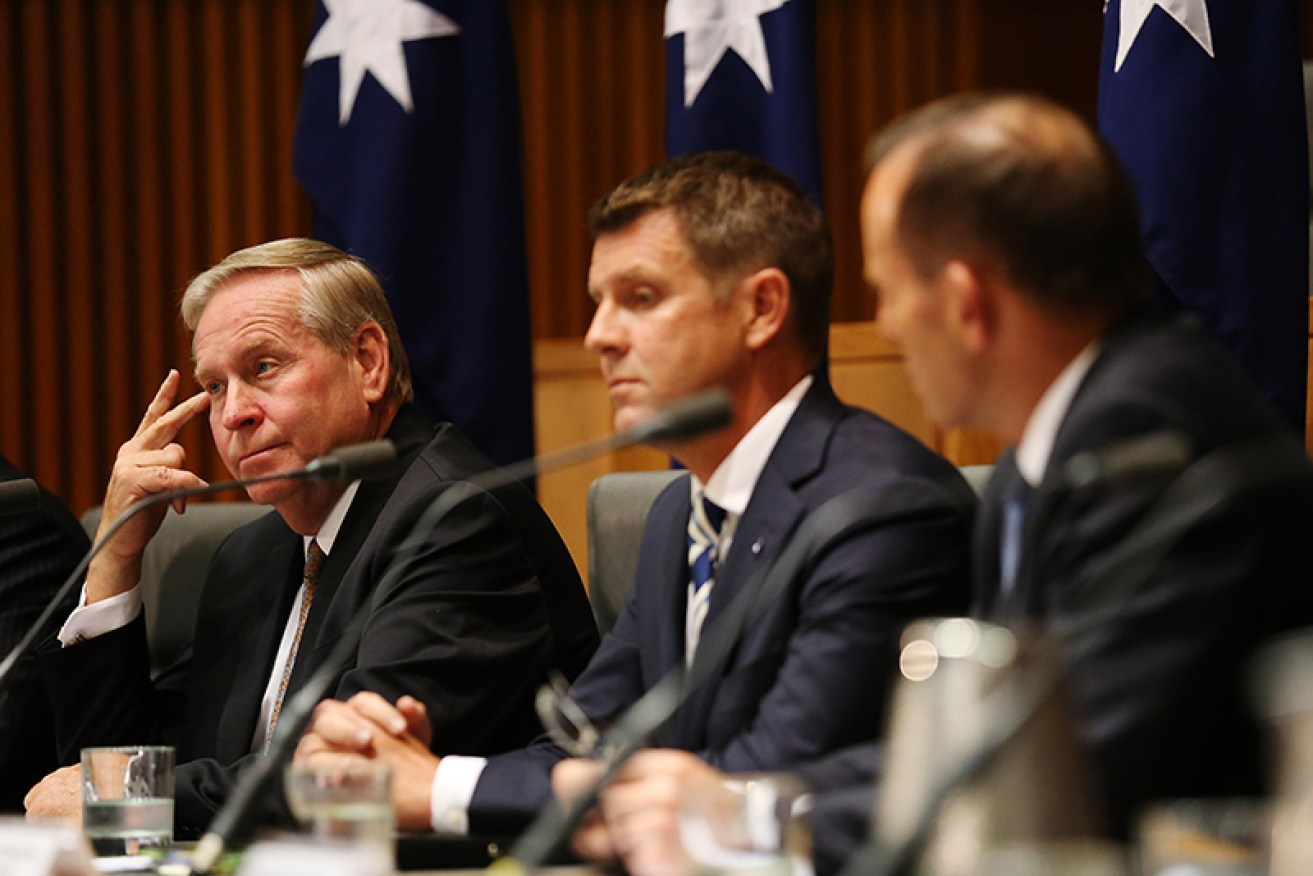Is WA Premier Colin Barnett a whinger or a victim?


AAP
At Friday’s meeting of state leaders in Canberra, Western Australia Premier Colin Barnett made no secret of the fact that he was seriously ticked off about something.
While the other state premiers waxed lyrical about the bipartisanship of the affair, Barnett sat there fuming. You could almost see the steam coming out of his ears.
When his turn came to speak, he declared, “I must have been at another meeting”, then fired a verbal broadside at the PM and his fellow premiers.
• GST reform on the horizon
• How the GST is carved up
• How Australia squandered the mining boom
His fury was over the share of the goods and services tax (GST) his state is due to receive next financial year. And on the face of it, he appears to have a point.
In 2015/16, Western Australia is due to receive, per head, an absolutely minuscule portion of GST revenue, and all at a time when the state’s main product, iron ore, is plummeting in value.
But one economist says Mr Barnett has no one to blame but himself for the current state of affairs, and the strife he now finds himself in was easily foreseeable and easily avoided.
But before we go into that, here is a break down of exactly how much GST revenue each state will receive in the coming financial year.
As you will see, the distribution is puzzlingly lopsided.

WA is far and away the big loser, judging by its share of GST revenue in isolation. Photo: Shutterstock
BIG LOSER: Western Australia
Population: 2.6 million
GST payment: $1.9 billion
Per capita payment to the dollar: 30 cents
Second last: Victoria
Population: 5.8 million
GST payment: $12.8 billion
Per capita payment to the dollar: 89 cents
Third last: New South Wales
Population: 7.4 million
GST payment: $17.3 billion
Per capita payment to the dollar: 95 cents

Northern Territory will receive 18 times as much GST money per person as WA. Photo: Shutterstock
BIG WINNER: Northern Territory
Population: 244,000
GST payment: $3.4 billion
Per capita payment to the dollar: $5.57
Second: Tasmania
Population: 513,000
GST payment: $2.2 billion
Per capita payment to the dollar: $1.80
Third: South Australia
Population: 1.7 million
GST payment: $5.5 billion
Per capita payment to the dollar: $1.36

Tasmania is a very distant second to the NT, Photo: Shutterstock
Fourth: Queensland
Population: $4.7 million
GST payment: $13 billion
Per capita payment to the dollar: $1.12
Fifth: ACT
Population: 387,000
GST payment: $1 billion
Per capita payment to the dollar: $1.10
How is it calculated?
GST distribution is decided by an independent, non-political government agency called the Commonwealth Grants Commission (CGC). And the way it does it is very scientific, if a little convoluted.
Next financial year, the CGC estimates the GST will raise $57 billion. That would equal approximately $2,450 per person.
Given Western Australia’s population is about 2.6 million, you would expect the WA government to get $6.1 billion.
But that is not how the GST works. The philosophy behind the tax is that it distributes wealth between states so that they all receive an equal share according to their needs (‘horizontal fiscal equalisation’ is the technical term).
This means that iron ore-rich Western Australia will only get $1.9 billion. In other words, it will only get 30 cents to the dollar.
Meanwhile, New South Wales will receive 94 cents to the dollar, Victoria 89 cents to the dollar, and the Northern Territory a staggering $5.57 to the dollar.
This is all worked out systematically, based on how much revenue a state government is able to levy on things like mining royalties, stamp duty and payroll tax. If it is to be scientific about it, the CGC can only work with past data. Therefore its 2015/16 share of the GST is based on old data, when the iron ore market was booming and Western Australia was making a killing on mining royalties.
Since then, the mining boom has ended and iron ore has plummeted from $180 a tonne to $50 a tonne, putting WA is in a tight spot.
Mr Barnett says the CGC’s strict methodology is “exacerbating the cyclicle swings”, adding: “It’s dysfunctional and time’s up.”
“The reality is WA is effectively borrowing money to make payments to other states.”

Colin Barnett: victim of inequity, or economic mis-manager?
So, is Barnett right?
According to Melbourne University economist John Freebairn, Barnett has no one to blame but himself.
He argues that Western Australia knew how the GST distribution was calculated, and it should have been smarter during the good times. He says the CGC has no option but to used old data to calculate the distribution rates.
“It’s about the only data that they’ve got. If you look at the Commonwealth Treasury or any forecaster, their predictions of commodity prices are not worth two bob. They get paid a hell of a lot, but they’re as inaccurate as buggery.”
While this policy of using old data has left WA in a tight spot, it also had its advantages.
“When iron ore prices were really high, WA wasn’t being penalised. So they got this windfall gain,” says Dr Freebairn.
“Anybody who was smart would have said, ‘Listen, these prices aren’t going to last, we know the rules of the CGC, we know almost certainly at some stage these super-high prices will fall, we don’t know exactly when, and we don’t know by how much’.
“If they’d been smart, they would have put some away. They could have had a sovereign wealth fund, or they could have spent it on one-off infrastructure. Whereas they seem to have locked themselves into quite a lot of additional health, education, etc.”
It is these commitments that Mr Barnett is now struggling to pay for. Without a bigger share of GST, he will need to resort to borrowing money. But without a triple A credit rating, that will be expensive.
Far from being a cause for righteous indignation on the part of the embattled premier, Mr Barnett’s woes could therefore easily be interpreted as a lesson in how to mismanage a once-in-a-lifetime mining boom.








